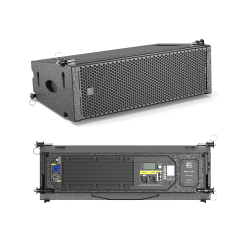When it comes to sound quality, and coverage – especially outside or a larger venue in general there are several advantages of using a line array sound system. Perhaps the single biggest benefit is uniform sound dispersion. Whereas traditional point source speakers cast sound in all directions with rapid drop offs in SPL (sound pressure level) over distance, line array systems really work to distribute the sound evenly. To cause that they produce a cylindrical wavefront whereby SPL loss decreases to only 3 dB / doubling of distance (as opposed the typical point source system where this is -6dB). In practice, this allows the same audio to be heard regionally in high fidelity and equal volume as those who might have been at the front of each over an entire large event (such as a concert / performance or festival).
Line array systems can also provide vertical control. Line arrays are composed of multiple speaker modules stacked on top of each other that focus the sound in a tight beam vertically while maintaining wide dispersion horizontally. The directional design of the enclosure drastically reduces sound reflections off ceilings and floors, thereby minimizing secondary reverberant stage which tends to muddle up specific speech or vocals in a vast open area with poor acoustics. Even in tough environments such as sports arenas…, rather than using reflection to your advantage. …. which can be the most difficult area of reflections…. you use multiple arrays along with line array theory and logic corrections to provide highly intelligible sound at every seat so patrons receive a consistent audio experience regardless of their location within that arena.
Scaleability is another huge benefit of line array systems. Their modular design allows them to scale in both size and acoustics for any given event. A small venue may get by on a couple of speaker modules, whereas a large event might need dozens per side to achieve the desired area coverage. This versatility enables sound engineers to tailor the system for different environments while maintaining high-quality audio. Large events, including the Glastonbury Festival deploy scalable line arrays combination to supply sound coverage for every person many attendees across multiple areas and point.

These features makes it simple to point out that clarity and precision are the biggest advantages of line array systems in terms of sound reproduction. This design means that there is minimal interference between frequencies, resulting in both the high and low frequency arrivals being delivered clearly and accurately. This is especially important with live music performances and public speaking events, where speech intelligibility and faithful musical reproduction are top of the list. In the professional audio applications line arrays can provide, acoustic difficulties call for clarity at all costs. “…A properly designed and implemented line array…should have essentially perfect vocal intelligibility,” notes industry vet Bob McCarthy[2], emphasizing a brand of versatility which is beyond simply handy to achieve but actualized with high performance results on constant replay far too frequently than many hope it need be.
It is also power efficient. Line array systems are engineered to provide higher output levels than traditional speaker arrays using fewer pieces per scale, therefore reducing the necessary power. This means the energy goes to where it counts most, and so less power is lost in unnecessary places and more of what you put through your system comes out as sound for the audience. In particular, this can make a line array system 30% less powerful and cost-effective to the same SPL (Sound Pressure Level) of direct source systems such as an element box or point study smaller for large-scale events than in reverberant environments.
Most modern line array systems benefit from EASE OF SETUP, etc., as these often combine a powered solution with integrated DSP (digital signal processing is sort for me). DSP allows the sound engineer to tune a system in more detail, by setting parameters such as EQ values, delay and crossover settings specific for that room. This feature enables HEOS to walk you through the setup process, so that the system can deliver perfect sound with minimal fuss. Meyer Sound LEO Family — made famous for its intuitive user interfaces and refined DSP capabilities that make set-up a breeze with intricate control over the audio landscape.
Sound is the # 1 factor in music production Bruce Swedien -Michael Jackson's Sound Engineer Cheeky, but also a wise man. It is the magic that makes music happen. How the use of a sound system line array can turn an average audio experience to extraordinary.
So to sum up. the benefits of line array sound systems are even, vertical control scalability clarity power efficiency easy setup and operation For this reason, line arrays are still used on many large scale events where high quality sound and coverage consistency is required.